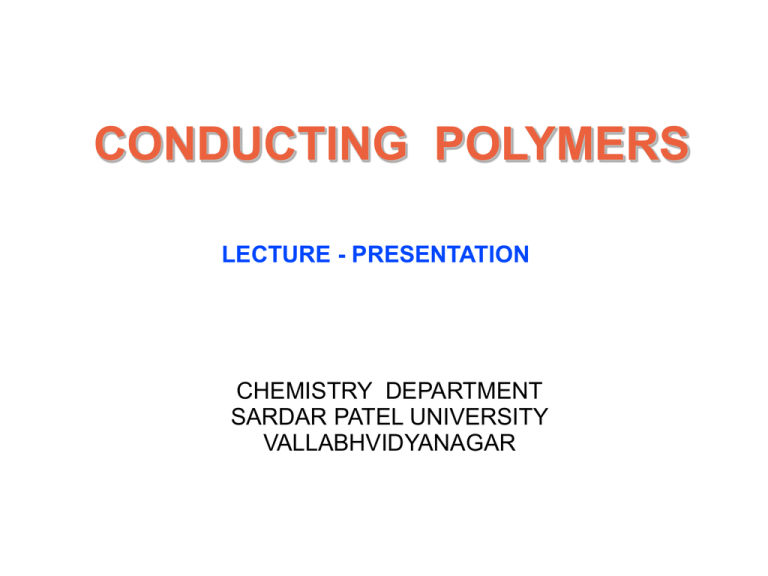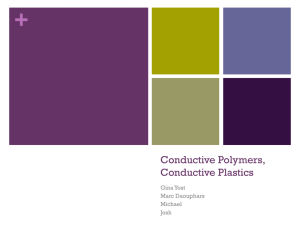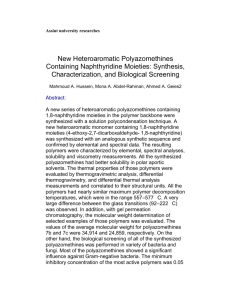Lecture: Conducting Polymers (powerpoint)
advertisement

CONDUCTING POLYMERS LECTURE - PRESENTATION CHEMISTRY DEPARTMENT SARDAR PATEL UNIVERSITY VALLABHVIDYANAGAR EVERY LIFE IS UNIQUE AND HAS A PURPOSE ELECTRICAL BEHAVIOUR OF POLYMERS SUPER-CONDUCTOR CONDUCTOR SEMI-CONDUCTOR INSULATOR RESISTENCE ORDER INTRA-MOLECULAR BEHAVIOUR INTER-MOLECULAR BEHAVIOUR WIRES-LINEAR CHAIN ORDER-CLOSE-PACKING UNSATURATION CONJUGATION POLYMERISATION DOPING Conducting polymers have backbones of contiguous sp2 hybridized carbon centers. One valence electron on each center resides in a pz orbital, which is orthogonal to the other three sigma-bonds. The electrons in these delocalized orbitals have high mobility, when the material is "doped" by oxidation, which removes some of these delocalized electrons. Thus the p-orbitals form a band, and the electrons within this band become mobile when it is partially emptied. In principle, these same materials can be doped by reduction, which adds electrons to an otherwise unfilled band. In practice, most organic conductors are doped oxidatively to give p-type materials. The redox doping of organic conductors is analogous to the doping of silicon semiconductors Calculations can be made of highest occupied molecular orbital energy, lowest unoccupied molecular orbital energy, ionization energy, electron affinity, and reorganization energy of a molecular system. Designing Polymers The first step in designing a polymer is to ask what kind of properties one wants: What kind of solubility do you want? What kind of solvents are you working with? Do you want it solid? Crystalline? Conductive? Semi-conductive? An insulator? Superconductive? What kind of flexibility? What kind of length? Do you need to control the length? Do you need anisotropic properties? Should it be thermally conductive as well as electrically? What about mechanical properties ? Structures of various conductive organic polymers. Polyphenylenevinylene, polyacetylene, polythiophene (X = S) and polypyrrole (X = NH), polyaniline (X = N, NH) and polyphenylene sulfide (X=S). POLY-ACETYLENES The year was 1977. Hideki Shirakawa, Alan MacDiarmid, and Alan Heeger (winners of the 2000 Nobel Prize in Chemistry) published their discovery that upon reaction with iodine, polyacetylene exhibited electrical conductivity many orders of magnitude higher than the neutral unreacted film. Here, it seemed, was a polymer chain on which electrons could move—a molecular conductor. Chemists and physicists who dreamed of lightweight batteries and a replacement for copper power lines, and the billiondollar market for these products, got their hopes up; their goal seemed just over the horizon Three different types of thermoplastic elastomers, styrenebutadiene-styrene, styrene-isoprene-styrene, and styreneethylenebutylene-styrene triblock copolymers have been blended with polyacetylene utilizing various blending techniques. In one method, acetylene gas was polymerized with the Ziegler-Natta catalyst in the presence of either the thermoplastic elastomer film or a hydrocarbon solution of the thermoplastic elastomer. The resulting polyacetylene/thermoplastic elastomer blend has been characterized. Upon doping with either iodine or ferric chloride, the ultimate conductivities of the blends were found to be 60–100 Ω−1 cm−1. Polyacetylene shows catalytic activity in an aqueous solution for electroless deposition of amorphous alloys. The catalytic activity of polyacetylene is comparable to the activity of some highly catalytic metals, i.e., Cu, steel, and Pt. Modifications of the Shirakawa technique led to the formation of a foam-like polyacetylene, which is highly porous and has a low degree of crystallinity. This material can be used as a catalytic substrate for the preparation of amorphous metals in bulk form. . Helical polyacetylene was synthesized under an asymmetric reaction field consisting of chiral nematic (N*) liquid crystals (LCs). The chiral nematic LC was prepared by adding a chiroptical binaphthol derivative as a chiral dopant to a mixture of two nematic LCs. Acetylene polymerizations were carried out using the catalyst titanium tetra-n-butoxidetriethylaluminum dissolved in the chiral nematic LC solvent. The polyacetylene film was shown to consist of clockwise or counterclockwise helical structure of fibrils.. The high electrical conductivities of ~1500 to 1800 siemens per centimeter after iodine doping and the chiral helicity of these films may be exploited in electromagnetic and optical applications. POLY-p-PHENELYNES Coated substrates are being tested for transparency in the visible region and for opacity to RF and IR radiation. China Lake's approach is to build upon the successful arylene vinylene polymer chemistry in conducting polymers and second-order non-linear optical polymers. The approximate chemical structure of a new polymer is shown in the figure. A particularly interesting area of research involves shifting the absorption bands of the oxidized polymer (conducting) outof the visible region by shifting the absorption of the neutral polymer (insulating) into the IR. This principle is shown in the figure Morphological, structural and chemical characterization demonstrate unambiguously that coaxial nickel/poly(pphenylene vinylene) (PPV) nano-wires have been successfully synthesized. Moreover, modification of their optical and magnetic properties due to the nano-scale and the core–shell structure has been studied. The nickel-PPV nano-wires exhibit a slightly blue-shifted photoluminescence (PL), which is directly related to the tubular morphology of the PPV shell. The ferromagnetic behaviour has been shown with the magnetization easy axis along the wire axis. These arrays of coaxial conducting polymer–metal nanowires embedded in a polymer membrane are interesting for flexible electronics and photovoltaic devices and their possible use as multifunctional building blocks for bioapplications. Poly(p-phenylene) (PPP) was chemically synthesized via oxidative polymerization using benzene and doped with FeCl3. The electrical conductivity response of the doped PPP (dPPP) towards CO, H2 and NH3 is investigated. dPPP shows no electrical conductivity response towards the first two gases (CO and H2), but it shows a definite negative response towards NH3. The electrical conductivity sensitivity of dPPP increases linearly with increasing NH3 concentration. To improve the sensitivity of the sensor towards NH3, ZSM-5 zeolite is added into the conductive polymer matrix. The electrical sensitivity of the sensor increases with increasing zeolite content up to 30%. The PPP/Zeolite composite with H+ possesses the highest electrical sensitivity of −0.36 since H+ has the highest acidity, the highest pore volume and surface area, which combine to induce a more favorable NH3 adsorption and interaction with the conductive polymer. POLY-PYRROLES Poly-pyrrole films are formed by casting a pyrrole derivative (say, 3-hexadecyl pyrrole) in an organic solvent on an air-water interface where the water subphase contains an oxidant (FeCl3). Free pyrrole as the vapor is added to cause polymerization. They are excellent conductors. The use of electrochemically synthesized polypyrrole film is investigated as a primer for protective coating on carbon steel. It provides excellent adherence and corrosion resistance, and is more environmentfriendly. Polypyrrole was galvanostatically synthesized on carbon steel, and epoxy paint top coat was applied on it. The corrosion performance was evaluated using salt spray test, Tafel plots, and electrochemical impedance spectroscopy. The performance was compared to that of a commercial zinc primer. These tests coherently demonstrate that the use of polypyrrole film inhibits corrosion better than a zinc primer in salt and acid environments. Porous, highly uniform and ordered polypyrrole nanowire and nanotube arrays were fabricated by chemical oxidation polymerization with the help of a porous anodic aluminium oxide (AAO) template. Under 0.2 mol/L pyrrole (H2O) and 0.2 mol/L FeCl3 (H2O) pattern, polypyrrole nanowire arrays were obtained after 2.0 hour's polymerization reaction in a two-compartment reaction cell. When the reaction was stopped after 15 minutes, polypyrrole nanotube arrays have been formed. The diameter,length and density of compositive nanowires and nanotubes could be controlled by parameters of AAO template. POLY-ANILINES Properties of Polyaniline Polyaniline’s electrical properties can be reversibly controlled by charge-transfer doping and protonation. Polyaniline is environmentally stable and inert (noble) where stainless steel is corroded. Polyaniline is applicable to electrical, electrochemical, and optical applications. Polyaniline is currently used in cell phones and calculators, and other LCD technology. Oxidation States and Acid Base Behavior of Polyaniline (emaraldine, pernigraniline) A novel room-temperature route to corrosion protect leadcoated plastic grids with an organic metal, namely, polyaniline, for producing commercial-grade high specificenergy 12 V/45 Ah lead-acid batteries is reported. The specific energy of these lead-acid batteries is found to be ca. 45 Wh/kg as against about 30 Wh/kg for conventional leadacid batteries. The new corrosion protection technology with polyaniline is based on an immense surface ennobling and the formation of a passivating metal oxide. Electrically and optically active polyaniline films doped with camphorsulfonic acid derivatives were successfully deposited on non-conductive substrates via chemical vapor phase polymerization. The polyaniline films grown by this method not only showed high electrochemical activity, but also exhibited optical activity corresponding to the polymer chains. Concentrated solutions of high-molecular weight polyaniline using amines as gel inhibitors: Certain amine compounds (gel inhibitors) are used to form highly concentrated, stable solutions of the emeraldine base form of polyaniline in numerous organic solvents from which coatings, films and fibers are readily prepared without problems associated with rapid gelation which occurs when concentrated solutions are attempted without the use of the gel inhibitors of the present invention. The corrosion inhibition properties of polished steel plates (low carbon) coated with a polyaniline (emeraldine base form) blend with nylon 66 (termed PANi/Ny) via cast method with formic acid as the solvent. Polyaniline (PANi) was prepared chemically from aqueous solution using aniline (0.2 M) as a monomer and ammonium persulfate (0.2 M) as an oxidant. The polymer powder produced was changed into emeraldine base (EB) form after treatment with dilute ammonia solution (0.5 M) in order to do further processing. Aniline electropolymerization on a DNA-modified glassy carbon electrode gives rise to a stable composite DNA-polyaniline film possessing redox activity over a wide range of pH values. The heights and potentials of the redox peaks linearly depend on pH in the pH 3.0–8.0 range. It was established that the inclusion of DNA into the polyaniline composition enhances considerably the film conductivity and capacitance in the weakly acid and weakly alkaline pH regions; this effect is most pronounced for the reduced polymer form. The properties of the prepared DNA-polyaniline film point to its promise for the use in electrochemical biosensors. GENERAL CHARACTERISTICS The organic metal can display a unique set of properties: It is more noble than copper and slightly less noble than silver. t can act as a catalyst. t can build very thin, though conductive and reactive, layers, or thin transparent conductive coatings. Carbon nano-tubes combined with electroactive polymers are considered to contribute to further progress in nanoelectronics and to the development of improved electronic and optoelectronic devices. A common feature of the ORGANIC METALS is a huge electronic anisotropy originating from their anisotropic crystal structures. Ratios between electrical conductivities in different directions reach values of up to 1 million! Therefore, they are often considered as quasi-two-dimensional or quasi-onedimensional conductors. Another remarkable feature characteristic of many organic metals is strong electron-electron and electron-phonon interactions. Plexcore® polymers and printable inks are the key ingredients in the formation of high-quality organic layers. Whether for next-generation, power efficient displays, low-cost, easily available plastic solar cells or item-level radio-frequency tags, Plexcore® polymers and inks deliver the performance to drive the adoption of these devices From a technology standpoint, all printed electronic applications require one or more conductive layers that can be integrated with organic semiconductors, dielectrics and other conductive films. Plexcore® OC is a solution-processable, organic conductive ink that can serve multiple functions in printed electronic devices. Plexcore® OC inks are ideal for integration into various printed electronic devices because they can be tailored to the particular needs of a device. Additionally, Plexcore® OC inks are chemically and thermally stable, making them easy to use in the production environment. SEMI-CONDUCTORS METALLO-ORGANIC POLYMERS Metal-containing conducting polymers can be divided into three types, known as types I, II and III . These are tethered, coupled and incorporated respectively. Type I polymers have the metal group tethered to the conjugated backbone by a linker moiety such as an alkyl group. In these cases the polymer acts as a conductive electrolyte and the metal ions act in similar way to an untethered group. Type II polymers have the metal directly coupled to the polymer backbone or coupled to the backbone by a conjugated linker group, which makes it easier for the polymer and the metal group to affect each other's properties directly. Since conducting polymer backbone and many metal ions are redox-active, systems can be electrochemically tuned. The third type of polymer has the metal group directly incorporated into the conjugated backbone. In this type the metal group has the greatest influence on the properties of the conducting polymer. The ability to alter the oxidation state of the metal ion, and thus the charge density along the polymer backbone, provides an alternative route to charge carrier creation as opposed to redox doping. Several methods of synthesizing these polymers are possible. These include condensation , ring opening metathesis and electropolymerisation. Electropolymerisation is a common method for synthesizing types I and II and often results in insoluble thin films of polymer being made. The insolubility of these films can make their characterization difficult, as solution methods cannot be used. Many of these type I and II polymers are based upon heterocyclic aromatic compounds such as pyrrole and thiophene. Most type III polymers cannot be electrochemically synthesized. Only thiophene based type III polymers have been successfully electropolymerised. Ring opening and condensation methods are more commonly used to prepare this type of polymers. Examples include ferrocene based polymers,polysilanes and metal polychelates of bischelating ligands. We were the first to prepare and study type III metal-ligand semiconductors. The ligands prepared were 1,5 diformyl 2,6 dihydroxy naphthalene and 1,5 diacetyl 2,6 dihydroxy naphthalene and their oximes. Cu(II), Ni(II) and Co(II) chelates of these ligands were investigated for their conducting behaviour. Polyamides and their poly chelates have values at 298K of about 10– 6 to 10-11 ohm-1 cm-1. Marcu and Dima3 have prepared the polymers of dimethyl–4,4'–[p– phenylene–bis (methylidene nitrilo)] disalicylate with Co(II), Ni(II) and Cu(II) in DMF and reported that these polymers are heat stable, semi conducting in nature. Semiconducting properties of poly chelates of 2, 5–dihydroxy phthaldehyde and series of tetra amino compounds have been reported. Coordination polymers of Cu(II) and Ni(II) with ethylene diaminetetrahalato and tetra thioazalatotetrathio flavane were prepared and their electrical conductivity has been studied Electrical conductivity studies on Co(II), Cu(II), Ni(II) and Cd(II) complexes of azines derived from benzophenone hydrozone with different aldehydes in presence of few drops of concentrated hydrochloric acid in alcoholic medium have been reported.. A number of complexes and other metal containing groups can be tethered to a conjugated polymer backbone. These include various porphyrin complexes, ferrocene, bipyridyl groups, and crown ether complexes. ferrocene porphyrin crown ethers: 12-crown-4, 15-crown-5, 18-crown-6, dibenzo-18-crown-6, and diaza-18crown-6 SUPERCONDUCTORS A superconducting polymer is the latest innovation to emerge from the recent explosion of research into organic superconductors. Bertram Batlogg and colleagues at Bell Laboratories in the US have achieved resistance-free current flow in poly(3hexylthiophene) at 2.35 kelvin. Batlogg and co-workers allowed a solution of poly(3-hexylthiophene) - or P3HTP - to solidify into thin films. The films were found to consist of tiny crystals of polymer interspersed with amorphous regions. Resistance-free current flows when the films are cooled below 2.35 K, and the relationship between conductivity and temperature is typical of that in polycrystalline superconductors. This is thought to result from the co-existence of the superconducting nanocrystals and the insulating amorphous areas. NON-POLYMERIC CONDUCTORS CHARGE-TRANSFER COMPLEXES Most materials composed of organic molecules are normally not metals because of hybridization which leaves their conduction and valence bands filled. This property was first overcome by combining planar organic molecules with non-organic anions (ClO4, PF6 etc.) which serve as acceptors or donors thus resulting in the appearance of partially filled conduction and/or valence bands. Such materials are charge transfer salts. The electrical and optical properties of the four charge-transfer salts formed between the two donors tetrathiafulvalene (TTF) and dibenzotetrathiafulvalene (DBTTF) and the two acceptors tetracyanoquinodimethan (TCNQ) and 2,3dichloro-5,6-dicyano-p-benzoquinone (DDQ ) are compared. The differences are rationalized on the basis of electrochemical considerations. DBTTF– TCNQ, the compound composed of the weakest donor and acceptor, is found to be a neutral complex. However, TTF–TCNQ, and the new material DBTTF–DDQ are mixed valence and highly conducting. The latter material, which is the first highly conducting salt to contain the common acceptor DDQ, has a room temperature pellet electrical conductivity of 8 Ω−1 cm−1. Thanks.






